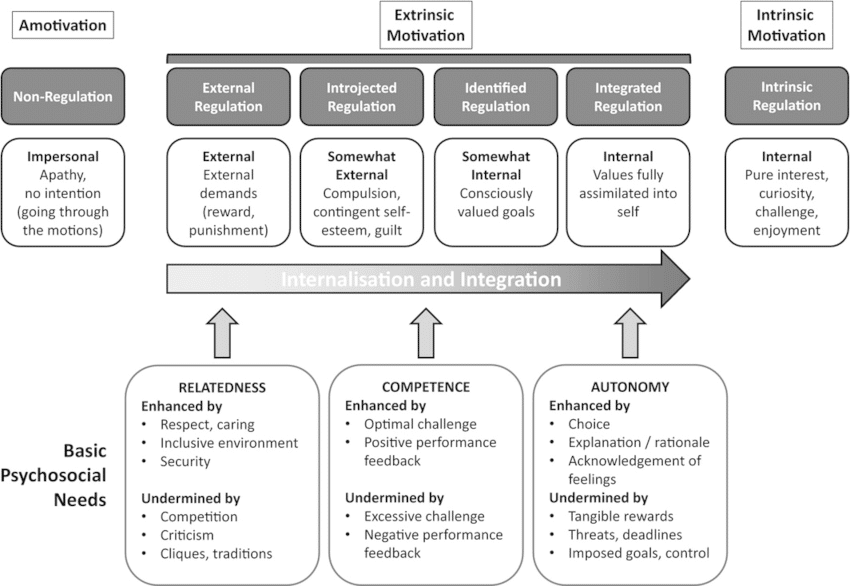The average CMO may no longer be familiar with Maslow’s theories since leaving University, but having expanded earlier in our blog about his Hierarchy of Needs theory, we felt it appropriate to offer his equally respected Self-Determination Theory (SDT) to provide a fully-rounded approach to our knowledge base.
Self-determination theory is a macro-principles approach to human motivation and personality. It focuses on the relationship between people’s innate growth tendencies and their innate psychological needs. Self-determination refers to the motivation behind a person’s decisions in the absence of intrinsic and extrinsic influences and distractions, including what’s going on in their head when they make a purchase.
One of the key contributions to the development of SDT was research on intrinsic motivation. Intrinsic motivation is the act of doing something because it is enjoyable and satisfying to do so, rather than doing it for the sake of achieving an external goal. There is a taxonomy of motivations based on how internalised they are. This is where the effect of cognitive dissonance on consumer behaviour applies.
Internalisation is the active effort to internalise an extrinsic motivation into personally endorsed values, and thus assimilate behavioural rules that were originally external. In the following, Edward Deci expanded on the earlier work differentiating between extrinsic and intrinsic motivation, proposing three main intrinsic needs that drive self-determination. Deci and Ryan identified three fundamental psychological needs that motivate self-initiation and specify key nutrients for individual psychological well-being. The fundamental psychological needs are the universal and innate needs for autonomy, competence and relatedness.

Self-determination theory
Humanistic psychology had a major influence on the development of Self-Directed Therapy (SDT). Humanistic psychology focuses on a person’s psyche and personal success for self-empowerment and self-realisation. Whether or not a person is self-efficient and self-realised can influence their motivation.
SDT recognises the interdependence of intrinsic motivations as a way of motivating others to accomplish a goal. With the recognition of the interdependence of motivation, SDT formulates the belief that external motivations and the motivation of others may be beneficial. However, it’s more important for individuals to find the “why” behind the desired outcome within themselves.
Summary of the SDT mini-theories
i. Cognitive Evaluation Theory (CET): explains the relationship between intrinsic motivation and extrinsic motivation. According to the theory, extrinsic motivation is diminished when extrinsic motivations control individuals and push them to act in a certain way. Conversely, extrinsic motivations are informational and give feedback about behaviour, which increases intrinsic motivation.
ii. According to Organisational Integration Theory (OIT), there are four types of external motivators and how they help to socialise the individual. According to OIT, people voluntarily engage in activities or behaviours that they don’t find enjoyable or interesting because they are motivated by external factors. These external motivators are External Regulation, Introjected Regulation, Identifiable Regulation, and Integrated Regulation.
iii. Causality Orientation theory (COT) analyses how people motivate themselves to their personality. COT identifies three orientations of decision-making that are determined by determining the motivators behind an individual’s decision-making. Individuals may have an autonomy orientation where they make decisions based on their interests and values. They may also have a control orientation where decisions are made based on the various pressures that they face from both internal and external sources. On the other hand, an impersonal orientation is where people are overwhelmed with feelings of powerlessness, which is accompanied by a feeling that their decisions do not affect the outcomes of their lives.
iv. Basic Needs theory (BNT): considers three psychological needs that are related to intrinsic motivation, effective functioning, high-quality engagement, and psychological well-being. The first psychological need is autonomy or the belief that one can choose their behaviours and actions. The second psychological need is competence. In this sense, competence is when one can work effectively as they master their capacity to interact with the environment. The third psychological need proposed in basic needs theory is relatedness, or the need to form strong relationships or bonds with people who are around an individual.
v. Goal contents theory (GCT): compares the benefits of intrinsic goals to the negative outcomes of external goals in terms of psychological well-being. Key to this mini-theory is understanding what reasoning lies behind an individual’s goals. Individuals who pursue goals as a way to satisfy their needs have intrinsic goals and over time experience need satisfaction while those who pursue goals in search of validation have external goals and do not experience need satisfaction.
vi. Relationship motivation theory (RMT): examines the importance of relationships. This theory posits that high-quality relationships satisfy all three psychological needs described in BNT. Of the three needs, relatedness is impacted the most by high-quality relationships but autonomy and competence are satisfied as well. This is because high-quality relationships can provide individuals with a bond with another person while simultaneously reinforcing their needs for autonomy and competence.
Basic psychological needs
One of the mini-theories of Self-Relation Therapy (SDT) is called Basic Needs Theory. This theory proposes three fundamental psychological needs that need to be met to promote health and well-being. These three fundamental psychological needs are autonomy, competence and relatedness.
Autonomy
The desire to be the cause of one’s own life and live in harmony with one’s integral self; however, it is important to note that this does not mean being independent of others; rather, it is a sense of overall psychological freedom and freedom of inner will. When an individual is self-motivated, their performance, well-being, and engagement are enhanced rather than if they are told to do something (i.e., control motivation).
Competence
Seek to control the outcome and experience mastery.
Deci found that giving people unexpected positive feedback on a task increases their intrinsic motivation to do it, meaning that this was because positive feedback fulfilled people’s need for competence. Additionally, SDT influences the fulfilment of meaning-making, well-being, and finding value within internal growth and motivation] Giving positive feedback on a task served only to increase people’s intrinsic motivation and decrease extrinsic motivation for the task.
Relatedness
Will to interact with, be connected to, and experience caring for others.
During a study on the relationship between infants’ attachment styles, their exhibition of mastery-oriented behaviour, and their effect during play, Frodi, Bridges and Grolnick failed to find significant effects: Perhaps somewhat surprising was the finding that the quality of attachment failed to significantly predict either mastery motivation, competence, when other investigators have demonstrated an association between similar constructs.
Motivations
According to SDT, motivation isn’t a one-size-fits-all concept. Instead, it’s a way of thinking about what motivates you at any given moment. SDT distinguishes between different kinds of motivation and what comes out of them. According to White, deCharms and others, the need for autonomy and competence is the foundation of intrinsic motivation and behaviour. It’s a connection between people’s fundamental needs and their motivation.
Intrinsic motivation SDT links intrinsic motivation to cognitive and social development. Intrinsic motivation refers to an individual’s innate motivation to explore new challenges and opportunities.
Cognitive Evaluation Theory (CET) is a sub-theory of differential diagnosis (SDT) that describes the factors that explain intrinsic motivation with SDT and how they interact with it. Social and environmental factors play a role in helping or hindering intrinsic motivation. Cognitive assessment focuses on the need for competence and independence. CET explains motivational “crowding-out”.
Extrinsic motivation The source of extrinsic motivation is external. Deci (2006) and Ryan (2006) developed OIT (Organismic Integration Theory) as a subset of SDT. OIT describes the various mechanisms by which extrinsically motivated behaviour is controlled.
OIT details the different forms of extrinsic motivation and the contexts in which they come about. The context of such motivation concerns the SDT theory as these contexts affect whether the motivations are internalised and so integrated into the sense of self.
OIT describes four different types of extrinsic motivations that often vary in terms of their relative autonomy:
- Externally regulated behaviour: Is the least autonomous, it is performed because of external demand or possible reward. Such actions can be seen to have an externally perceived locus of control.
- Introjected regulation of behaviour: describes taking on regulations to behaviour but not fully accepting said regulations as your own. Deci and Ryan claim such behaviour normally represents regulation by contingent self-esteem, citing ego involvement as a classic form of introjections. This is the kind of behaviour where people feel motivated to demonstrate the ability to maintain self-worth. While this is internally driven, introjected behaviour has an external perceived locus of causality or does not come from one’s self. Since the causality of the behaviour is perceived as external, the behaviour is considered non-self-determined.
- Regulation through identification: a more autonomously driven form of extrinsic motivation. It involves consciously valuing a goal or regulation so that said action is accepted as personally important.
- Integrated Regulation: This is the most autonomous kind of extrinsic motivation. Occurs when regulations are fully assimilated with self so they are included in a person’s self-evaluations and beliefs on personal needs. Because of this, integrated motivations share qualities with intrinsic motivation but are still classified as extrinsic because the goals that are trying to be achieved are for reasons extrinsic to the self, rather than the inherent enjoyment or interest in the task.





